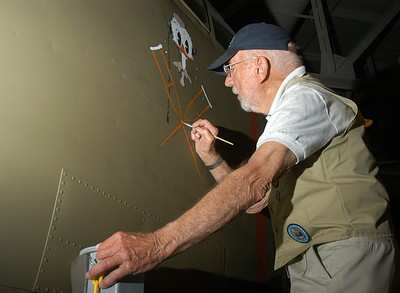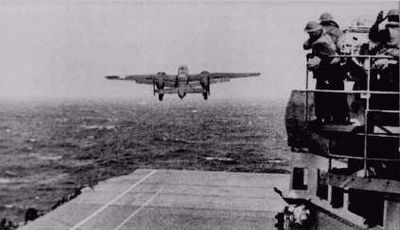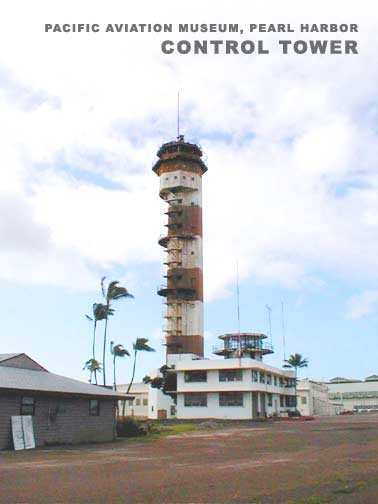Artwork Pays Homage To Doolittle Raid Bomber
Hal Olsen, a former Aviation Mechanic 1st Class during World War
II and professional aircraft nose artist, was greeted as a special
guest April 18 at the Pacific Aviation Museum on Pearl
Harbor’s historic Ford Island.

Olsen's unique art work emblazoned a B-25B bomber located at the
Pacific Aviation Museum and commemorated the historic aircraft's
use on the 65th anniversary of the April 18, 1942 Doolittle Raid on
Tokyo Bay.
His painting consisted of the "Ruptured Duck," a cartoon that
closely resembles the Disney character Donald Duck. The "Ruptured
Duck" wears radio headphones and is pictured above crossed
crutches.
It took Olsen a little more than four hours to finish the
aircraft's nose, but the final product was well received by the
museum's guests and staff.
Before the museum opened its doors to the public, Pacific
Aviation Museum curator Mike Wilson made some phone calls to the
famous aircraft nose artist.
The museum had a B-25B bomber flown by Army 2nd Lt. Ted Lawson
who was part of the famous "Doolittle's Raiders," and the seventh
plane to take off from USS Hornet (CV 8) for the bombing raid on
Tokyo.
Wilson felt the exhibit would need a special touch to showcase
the authenticity of the historic warplane. Olsen willingly agreed
to the task at hand and the Albuquerque, NM resident flew out to
Hawaii to a welcoming reception held by the museum.
"It's a feeling of great fulfillment and a great pleasure of
having been involved in this project since the inception," said
Wilson about Olsen's participation with the museum.

Olsen, whose works inspired good morale and esprit de corps to
military personnel during World War II, started his aircraft
nose-painting career after he had purchased a set of oil paints on
an overcrowded liberty ship while his fellow Sailors were out
buying souvenirs. Liberty ships were used as cargo ships during
World War II, and traveled to the different Pacific island bases
with supplies, but service members could also use the ships' stores
to buy personal items.
According to Olsen, he initially just wanted to paint the
beautiful scenery of Tinian Island, but after decorating the nose
of one fighter, his work gained recognition and pilots started
paying Olsen for his art.
"I was making $78 a paycheck and $50 per plane, and I was doing
about two or three planes a day," said Olsen.
The working artist's aircraft nose art would eventually don more
than 100 fighter aircraft across the Pacific, from PB-4Ys to B-29B
bombers. His work ranged from calendar girls to Disney-esque
cartoon characters.
Olsen would later opt out of the Navy in pursuit of following
his passion by attending art school, but later would be called upon
again for his creative talents as an aircraft nose artist by the
Pacific Aviation Museum.
The Pacific Aviation Museum resides on the National Historic
Landmark of Ford Island in a 42,000-square-foot former seaplane
hangar that survived the December 7, 1941 attack.

With actual aircraft from World War II, plus educational
interpretations of the Pearl Harbor attack, the Doolittle Raid on
Japan, the Battles of Midway and Guadalcanal, the museum and its
exhibits represent aviation's dedication to the defense of freedom
in the Pacific.
The Pacific Aviation Museum, which opened December 7, has
fast become a must-see historic attraction in Pearl Harbor.
(Aero-News salutes Mass Communication Specialist Seaman Eric
J. Cutright, Fleet Public Affairs Center Detachment
Hawaii)
 NTSB Final Report: Aviat A1
NTSB Final Report: Aviat A1 ANN's Daily Aero-Linx (07.08.25)
ANN's Daily Aero-Linx (07.08.25) Classic Aero-TV: Fly Corvairs Reliable Engine Alternative
Classic Aero-TV: Fly Corvairs Reliable Engine Alternative ANN FAQ: Contributing To Aero-TV
ANN FAQ: Contributing To Aero-TV Classic Aero-TV: CiES Fuel-Quantity and e-Throttle Systems Praised
Classic Aero-TV: CiES Fuel-Quantity and e-Throttle Systems Praised





